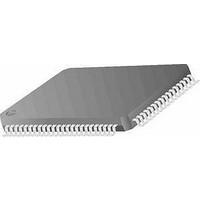MC9S12E64CFU Freescale Semiconductor, MC9S12E64CFU Datasheet - Page 497

MC9S12E64CFU
Manufacturer Part Number
MC9S12E64CFU
Description
IC MCU 64K FLASH 25MHZ 80-QFP
Manufacturer
Freescale Semiconductor
Series
HCS12r
Specifications of MC9S12E64CFU
Core Processor
HCS12
Core Size
16-Bit
Speed
25MHz
Connectivity
EBI/EMI, I²C, SCI, SPI
Peripherals
POR, PWM, WDT
Number Of I /o
60
Program Memory Size
64KB (64K x 8)
Program Memory Type
FLASH
Ram Size
4K x 8
Voltage - Supply (vcc/vdd)
2.35 V ~ 2.75 V
Data Converters
A/D 16x10b; D/A 2x8b
Oscillator Type
Internal
Operating Temperature
-40°C ~ 85°C
Package / Case
80-QFP
Data Bus Width
16 bit
Data Ram Size
4 KB
Interface Type
SCI, SPI
Maximum Clock Frequency
25 MHz
Number Of Programmable I/os
60
Number Of Timers
16 bit
Maximum Operating Temperature
+ 85 C
Mounting Style
SMD/SMT
Minimum Operating Temperature
- 40 C
On-chip Adc
10 bit
On-chip Dac
8 bit, 2 Channel
For Use With
M68EVB912E128 - BOARD EVAL FOR MC9S12E128/64
Lead Free Status / RoHS Status
Contains lead / RoHS non-compliant
Eeprom Size
-
Lead Free Status / Rohs Status
No RoHS Version Available
Available stocks
Company
Part Number
Manufacturer
Quantity
Price
Company:
Part Number:
MC9S12E64CFU
Manufacturer:
Freescale Semiconductor
Quantity:
10 000
Company:
Part Number:
MC9S12E64CFUE
Manufacturer:
Freescale Semiconductor
Quantity:
10 000
Part Number:
MC9S12E64CFUE
Manufacturer:
FREESCALE
Quantity:
20 000
Company:
Part Number:
MC9S12E64CFUER
Manufacturer:
Freescale Semiconductor
Quantity:
10 000
- Current page: 497 of 606
- Download datasheet (4Mb)
16.4.2.3
The definitions of begin- and end-trigger as used in the DBG module are as follows:
16.4.2.4
In DBG mode, arming occurs by setting DBGEN and ARM in DBGC1. The ARM bit in DBGC1 is cleared
when the trigger condition is met in end-trigger mode or when the Trace Buffer is filled in begin-trigger
mode. The TBC logic determines whether a trigger condition has been met based on the trigger mode and
the trigger selection.
16.4.2.5
The DBG module supports nine trigger modes. The trigger modes are encoded as shown in
The trigger mode is used as a qualifier for either starting or ending the storing of data in the trace buffer.
When the match condition is met, the appropriate flag A or B is set in DBGSC. Arming the DBG module
clears the A, B, and C flags in DBGSC. In all trigger modes except for the event-only modes and DETAIL
capture mode, change-of-flow addresses are stored in the trace buffer. In the event-only modes only the
value on the data bus at the trigger event B will be stored. In DETAIL capture mode address and data for
all cycles except program fetch (P) and free (f) cycles are stored in trace buffer.
16.4.2.5.1
In the A only trigger mode, if the match condition for A is met, the A flag in DBGSC is set and a trigger
occurs.
16.4.2.5.2
In the A or B trigger mode, if the match condition for A or B is met, the corresponding flag in DBGSC is
set and a trigger occurs.
16.4.2.5.3
In the A then B trigger mode, the match condition for A must be met before the match condition for B is
compared. When the match condition for A or B is met, the corresponding flag in DBGSC is set. The
trigger occurs only after A then B have matched.
Freescale Semiconductor
•
•
Begin-trigger: Storage in trace buffer occurs after the trigger and continues until 64 locations are
filled.
End-trigger: Storage in trace buffer occurs until the trigger, with the least recent data falling out of
the trace buffer if more than 64 words are collected.
Begin- and End-Trigger
Arming the DBG Module
Trigger Modes
A Only
A or B
A then B
When tagging and using A then B, if addresses A and B are close together,
then B may not complete the trigger sequence. This occurs when A and B
are in the instruction queue at the same time. Basically the A trigger has not
yet occurred, so the B instruction is not tagged. Generally, if address B is at
MC9S12E128 Data Sheet, Rev. 1.07
NOTE
Chapter 16 Debug Module (DBGV1)
Table
16-6.
497
Related parts for MC9S12E64CFU
Image
Part Number
Description
Manufacturer
Datasheet
Request
R
Part Number:
Description:
Manufacturer:
Freescale Semiconductor, Inc
Datasheet:
Part Number:
Description:
Manufacturer:
Freescale Semiconductor, Inc
Datasheet:
Part Number:
Description:
Manufacturer:
Freescale Semiconductor, Inc
Datasheet:
Part Number:
Description:
Manufacturer:
Freescale Semiconductor, Inc
Datasheet:
Part Number:
Description:
Manufacturer:
Freescale Semiconductor, Inc
Datasheet:
Part Number:
Description:
Manufacturer:
Freescale Semiconductor, Inc
Datasheet:
Part Number:
Description:
Manufacturer:
Freescale Semiconductor, Inc
Datasheet:
Part Number:
Description:
Manufacturer:
Freescale Semiconductor, Inc
Datasheet:
Part Number:
Description:
Manufacturer:
Freescale Semiconductor, Inc
Datasheet:
Part Number:
Description:
Manufacturer:
Freescale Semiconductor, Inc
Datasheet:
Part Number:
Description:
Manufacturer:
Freescale Semiconductor, Inc
Datasheet:
Part Number:
Description:
Manufacturer:
Freescale Semiconductor, Inc
Datasheet:
Part Number:
Description:
Manufacturer:
Freescale Semiconductor, Inc
Datasheet:
Part Number:
Description:
Manufacturer:
Freescale Semiconductor, Inc
Datasheet:
Part Number:
Description:
Manufacturer:
Freescale Semiconductor, Inc
Datasheet:











